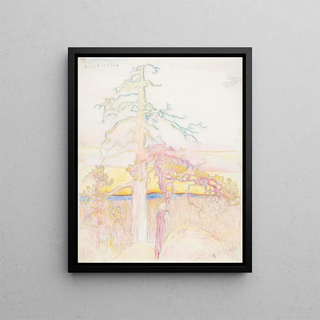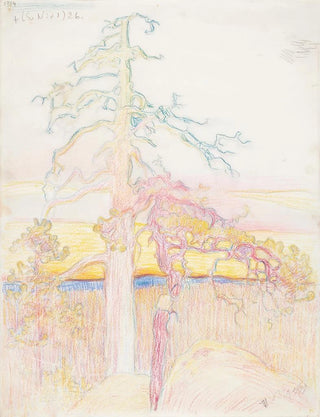Painting Pin dans la nature - Eero Järnefelt | Art print


View from behind

Frame (optional)
Reproduction of Pine in Nature - Eero Järnefelt – Captivating Introduction
In the landscape of Finnish art, the artwork "Pine in Nature" by Eero Järnefelt stands out for its delicacy and emotional depth. Painted at the end of the 19th century, this piece transports the viewer to the heart of a wild nature where light and shadow dance harmoniously. Järnefelt, an emblematic figure of the naturalist movement, manages to capture the very essence of the Finnish forest, a space that is both intimate and vast. The scene depicts a majestic pine, a symbol of resilience and beauty, emerging from a lush landscape. Through this representation, the artist invites silent contemplation, a moment of escape that resonates with the quest for authenticity of his time.
Style and uniqueness of the artwork
Järnefelt's style is characterized by meticulous attention to detail and a color palette inspired by nature itself. In "Pine in Nature," shades of green, brown, and blue blend to create an atmosphere that is both serene and lively. Light plays a central role, filtering through the branches and illuminating the trunk of the pine, giving the artwork an almost spiritual dimension. The artist's technique, oscillating between realism and impressionism, allows viewers to feel the movement of the wind in the leaves and the whisper of the surrounding nature. Each brushstroke seems to be an ode to the ephemeral beauty of life, transforming the painting into a true visual poem.
The artist and his influence
Eero Järnefelt, born in 1863, is not only a painter but also a passionate advocate for Finnish art. Trained at the Imperial Academy of Arts in Saint Petersburg, he was influenced by the great European masters while remaining deeply rooted in his Nordic identity. His work reflects a unique sensitivity towards nature, which he considers a sacred space to preserve. Järnefelt played a key role in promoting Finnish art internationally, and his style has inspired many contemporary artists. Through his work, he managed to establish a connection between man

Matte finish

View from behind

Frame (optional)
Reproduction of Pine in Nature - Eero Järnefelt – Captivating Introduction
In the landscape of Finnish art, the artwork "Pine in Nature" by Eero Järnefelt stands out for its delicacy and emotional depth. Painted at the end of the 19th century, this piece transports the viewer to the heart of a wild nature where light and shadow dance harmoniously. Järnefelt, an emblematic figure of the naturalist movement, manages to capture the very essence of the Finnish forest, a space that is both intimate and vast. The scene depicts a majestic pine, a symbol of resilience and beauty, emerging from a lush landscape. Through this representation, the artist invites silent contemplation, a moment of escape that resonates with the quest for authenticity of his time.
Style and uniqueness of the artwork
Järnefelt's style is characterized by meticulous attention to detail and a color palette inspired by nature itself. In "Pine in Nature," shades of green, brown, and blue blend to create an atmosphere that is both serene and lively. Light plays a central role, filtering through the branches and illuminating the trunk of the pine, giving the artwork an almost spiritual dimension. The artist's technique, oscillating between realism and impressionism, allows viewers to feel the movement of the wind in the leaves and the whisper of the surrounding nature. Each brushstroke seems to be an ode to the ephemeral beauty of life, transforming the painting into a true visual poem.
The artist and his influence
Eero Järnefelt, born in 1863, is not only a painter but also a passionate advocate for Finnish art. Trained at the Imperial Academy of Arts in Saint Petersburg, he was influenced by the great European masters while remaining deeply rooted in his Nordic identity. His work reflects a unique sensitivity towards nature, which he considers a sacred space to preserve. Järnefelt played a key role in promoting Finnish art internationally, and his style has inspired many contemporary artists. Through his work, he managed to establish a connection between man
12,34 €






